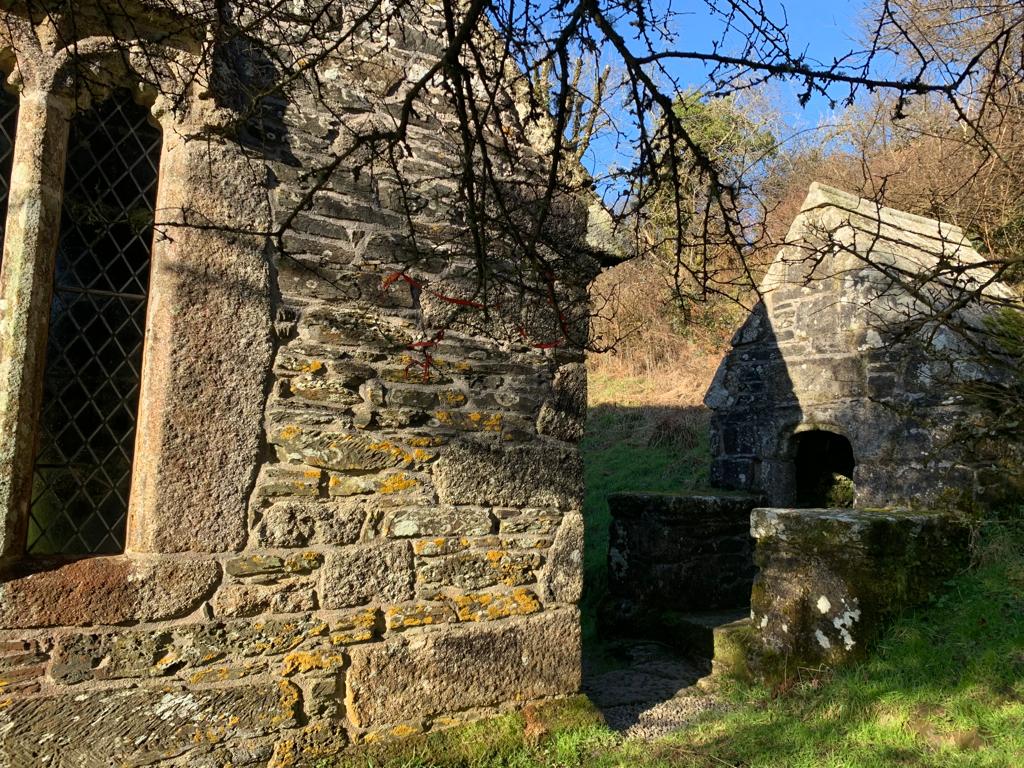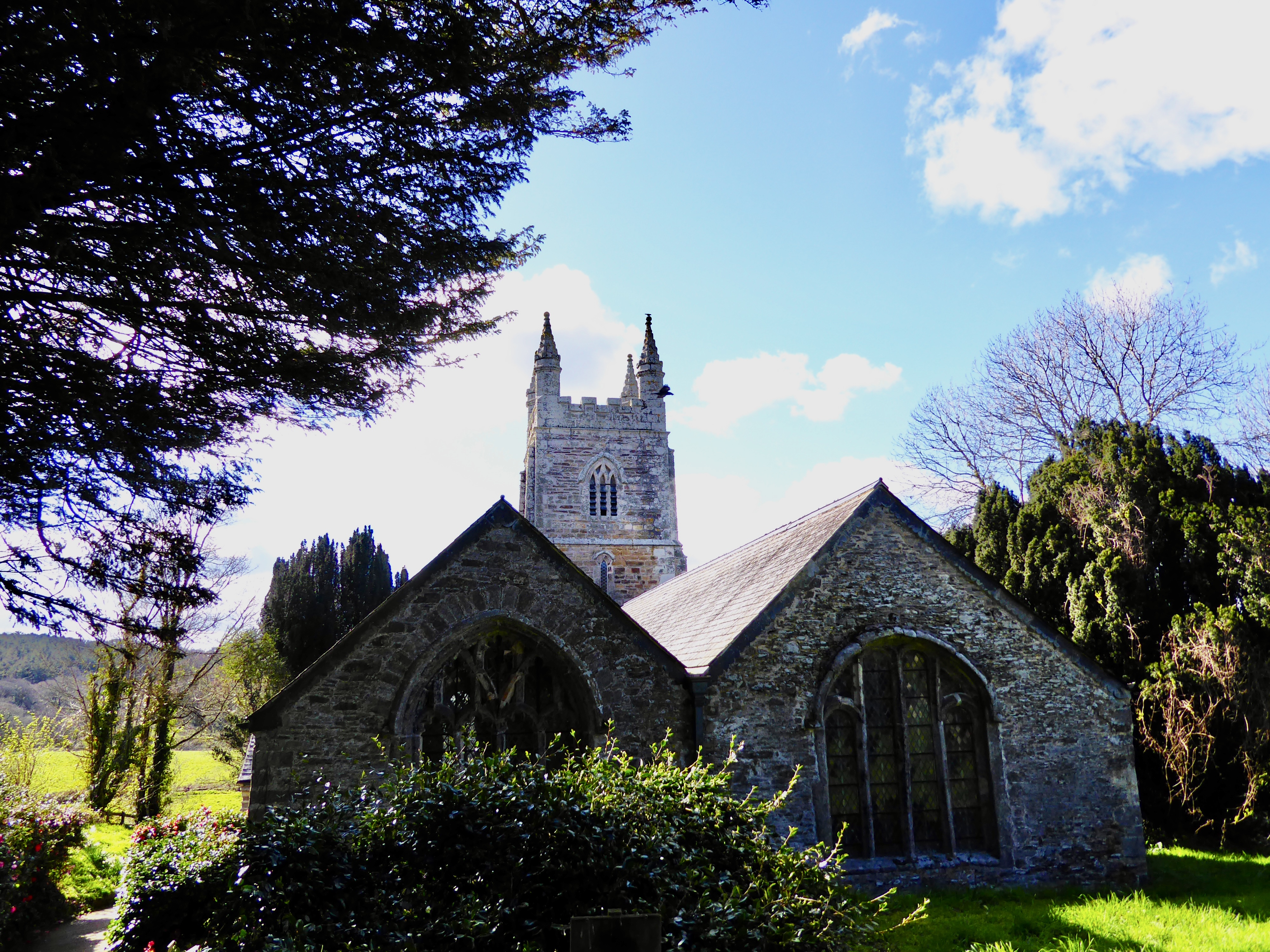
Celtic Saints: Names beginning with C
CADOC
Welsh male
Ball nr Mawgan
St Cadoc’s Holy Well is at Ball nr Mawgan. He built a hermitage here so Mawgan could hear his confession. He is Petroc’s nephew.
There is also the site of St Cadoc's chapel and holy well just outside Padstow on St Cadoc's Farm. St Cadoc's Point is a headland overlooking Harlyn Bay in the same area. The
life story of Cadoc was written around 1087 and details his journeys in Wales, Ireland, Scotland, Cornwall and Brittany. Many incredible and startling miracles are recorded in the biography.
CARANTOC
Welsh male
Crantock on north coast on River Gannel
He was a Welsh minor chieftain. He went to Ireland to learn under Patrick, then came to Cornwall in a coracle. He cast his altar stone into the sea as a guide. He had a pet dove that showed him the site where he settled. It’s on the River Gannel where the current Crantock church is sited. It was a missionary centre including Enedoc and Columb.
Legend: King Arthur asked him to rid the land of a marauding dragon. Carantoc prayed and immediately the dragon ran to him with a loud noise and bent its head. He put his priest’s stole around its neck. It didn’t harm him with its wings or claws. He didn’t kill it but led it away. He moved in the supernatural and miracles.
CLEER (Clarus)
male, English
St Cleer nr Bodmin Moor
He preached on the edge of Bodmin Moor and was celibate. He had a holy well and two Celtic crosses. The local chieftainess fell in love with him and pestered him so much he fled to France where he lived in an isolated hermitage. The angry woman pursued him and had him murdered.
His holy well in the village of St Cleer is one of the most ornate in Cornwall.

CLETHER:
Welsh, one of King Brychan's children
St Clether, Cornwall
A six century Christian missionary to Cornwall, along with his siblings. He settled in the valley of the River Inney where he established a hermitage prayer cell which is now the site of St Clether's holy well and chapel. Not much else is known about him except that he was buried on this site and it was known for healing miracles.

COLUMBA:
Irish female or possibly Scottish.
Ruthvoes, nr St Columb Major
Trevelgue
She lived in the 6th century. She was imprisoned by her parents for her faith but escaped them and a tyrant who wanted to marry her.
Columba became a Christian when the Holy Spirit appeared as a dove in a vision, promising her love and blessings. However her parents arranged a marriage for her to a pagan prince, even though she had taken a vow of virginity and refused to attend the pagan temple with them; she rejected the marriage, and her parents imprisoned her. An angel helped her escape leading her into the desert, but she was captured again by a local king, who admired her beauty and grace, and offered to marry her to his son if she renounced her faith.
She refused, was tortured on the breaking wheel and gallows but did not die, so was again imprisoned. An angel again helped her escape, and she fled to the coast, boarded a ship that took her to Cornwall and landed at what is now Trevelgue Head (possibly meaning red dirt, an indication of her martyrdom) The king followed her to Ruthvoes. (Blood red bank) in central Cornwall, 3 km south of St Columb Major and 10.5 km east of Newquay. He beheaded her. It’s said a spring burst up and followed the flow of her blood. There was also a well by the spring. She was buried at St Columb Major.
There are 4 crosses in St Columb Major. 2 in the churchyard, one Black Cross and another at Black Rock. In St Columb Minor she drove evil spirits away. The Celtic missionaries replaced pagan magic with Christian worship and a wooden sanctuary. In Celtic times it belonged to the monks of St Petroc in Bodmin.
CONSTANTINE:
Cornish
Constantine Bay nr Padstow
He was a Cornish king who became a Christian. His chapel and well are at Trevose golf club, hidden among the greens. He was converted by Petroc and became a monk in Ireland.
CORENTIN:

CRIDA
St Crida established her nunnery in 450AD on this land. She was the youngest daughter of King Mark (Conomorous in Cornish) who ruled over mid Cornwall from 515 to 560AD. He had a castle at Castle Dore near Golant and St Sampson's settlement. He is associated with Arthurian legends as having interaction with Tristan and Iseult a the nearby St Sampson Church in Golant.

Crida persuaded her father to give her the land by the River Fal to establish her nunnery. Just like the River Fowey, many travellers set sail from the River Fal having crossed central Cornwall to avoid sailing the dangerous waters around Land's End. Often they were refugees fleeing the invading Saxons. Many were traders or Christians on mission like herself. They then travelled on to France and the continent. This was her mission field and weary travellers found rest and sanctuary at the nunnery which was situated on the River Fal, probably at the top of its most navigable point and opposite the busy Roman fort at Golden on the opposite shore.
CUBY
Life in Cornwall
According to the 'Life of Saint Cybi', this saint was the son of Salomon a 'warrior prince', generally thought to have been a King of Cornwall. In the 'Bonedd y Saint', his father's name is given the Welsh form, Selyf. His mother, St Wenna (Gwen ferch Cynyr), was sister to St Non, mother of St David patron saint of Wales.
He was raised as a Christian and, in early life, went on a pilgrimage to Byzantine Judea and Jerusalem. In Judea, he found Jewish Christians and he became anointed by a Nazarene Christian who was a Jewish man, a descendant of Jesus' brothers. He arrived home to find that his father was dead and he was King of Cornwall. Cybi declined the throne and, instead, travelled through his kingdom, preaching to the people and building churches at Duloe, Tregony, Cubert and Landulph.
Life in Wales
He then moved on to south Wales founding churches at Llangybi between Usk and Caerleon in Monmouthshire, and Llanddyfrwr-yn-Edeligion, before spending some time in Ireland. He eventually sailed for north Wales settling at Llangybi on the Llynpeninsula. Off Anglesey King Maelgwn Gwynedd gave him the old Roman fort at Holyhead (subsequently known, in Welsh, as Caer Gybi, "Cybi's Fort") on Holy Island (thence called Ynys Gybi, "Cybi's Island"). He founded a large and important monastery there in the area where St Cybi's Church is now located.
Cybi was a great friend of Saint Seiriol. He would always face the Sun while travelling to meet him and his resulting tanned complexion led to him being known as Cybi Felyn or Cybi the Tanned. He is also said to have attended the Synod of Llanddewi Brefi in Ceredigion where he advised some pilgrims on their journey to Ynys Enlli (Bardsey). Rhyd-y-Saint railway station (English: Saints' Ford) on the Red Wharf Bay branch line near Pentraeth, was named so as Cybi and Seiriol are said to have met there.
Cybi died on 8 November 555 and was buried inEglwys y Bedd (the Chapel of the Grave) adjoining his monastery at Holyhead' (Reference. Wikipeadia)
CURY (Corentin, Corantyn, Corentinus
Cury on the Lizard Peninsula
Cury died in 490AD and was the first Bishop of Quimper in France (Cornouaille). He was a hermit living by a stream. He had a miraculous fish. He took a slice each day and the fish grew back.
CYOR
Irish
St Cyor’s well, Luxulyan a sacred well Christianised by Celtic saints